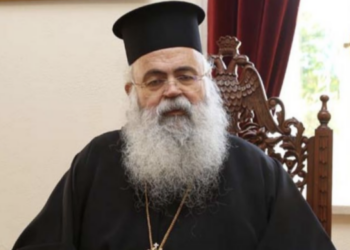LAST UPDATED: 11.15
At the age of 81, Archbishop Chrysostomos II of Cyprus reposed in the Lord on Monday morning (7/11).
The Archbishop of Cyprus fell asleep in the Lord today at 06.40 in the morning in his apartment in the Archdiocese, where he had been hospitalized for the last few weeks, battling cancer.
After the death of the Archbishop, the Metropolitan of Paphos Georgios takes over as guardian of the throne, until the election and enthronement of a new Archbishop.
Biography
Chrysostomos II (aka Herodotus Demetriou, born in Paphos on April 10, 1941) was a businessman and clergyman of the Orthodox Church and Archbishop of Nea Justiniani and All Cyprus – Primate of the Church of Cyprus. The Archbishop of Cyprus is the First among the Archbishops of Autocephalous Churches.
He was born in 1941 in the village of Tala in Paphos. Immediately after primary education, he became a cadet monk in the Holy Monastery of Agios Neophytos and then attended the High School of Paphos. He graduated from high school in 1963 and was ordained a deacon on November 3 of the same year.
Archiepiscopal election
After the long, irreversible illness of Archbishop Chrysostomos I, an Enlarged Synod was convened under Ecumenical Patriarch Bartholomew in Switzerland in May 2006, which declared the archdiocesan throne of Cyprus a widowhood.
Thus, the procedures for the election of a new Archbishop began, which were completed on November 5 of the same year with the election of Chrysostomos II. His enthronement took place on November 12 and, as reported by the media, he is the only Archbishop of Cyprus who performed the funeral of an Archbishop of Cyprus.
Work
Upon assuming his duties as Archbishop, he set goals for the better functioning of the Church of Cyprus. During his tenure, the Charter of the Church of Cyprus was updated and the Theological School of the Church of Cyprus was created.
Charter of the Church of Cyprus
Chrysostom II promoted the change of the outdated previous Charter of the Church, which was in force since 1914 and has since been revised twice. The new charter mainly changed the electoral system, upgrading the power of the faithful.
But the changes in the electoral procedure were not limited, but changed the borders of the metropolises (favored the occupied metropolis of Kyrenia), created a five-member synodal court, where the accused could be represented by a lawyer, and finally changed the procedures for the issuance of ecclesiastical divorce.
He also promoted the expansion of the Holy Synod with the reconstitution after 800 years of old bishops (Constantia, Tamasos, Trimythous, Karpasia, Ledra, Chytron, Amathous, Neapolis) that had been abolished during the Frankish rule by the Latins in 1222.
Thus, the Church of Cyprus, as an Autocephalous, succeeded in having a full Synod (with at least 13 members) which means that it can now convene a Great and Supreme Synod without the need for the participation of other Bishops from other Churches.
He also proposed and succeeded, following consultations with the Cypriot government and the Ministry of Finance, the creation of a Unified Payroll Body for the Clergy. In this way he achieved the independent payroll of the clergy and ensured the decent living of old and provincial clergy without burdening the state.
Theological school
The Archbishop succeeded in establishing the Theological School of the Church of Cyprus, a project which his predecessor, Archbishop Makarios III, had envisioned but failed to implement due to the Turkish invasion of Cyprus in 1974. The school was founded as a Private School of Higher Education but according to its regulation, it was founded and operates as a non-profit charitable educational organization.















